Dead is dead: Increased Alcohol-Related Deaths, U.S., 2020-2021
Increase of 33% during pandemic (through August 2021)
National Review picked up a recent JAMA Network letter:
More Americans 65 and Under Died from Alcohol-Related Causes Than Covid-19 in 2020, Study Finds
Alcohol-related deaths increased 25 percent from 2019 to 2020, with alcohol-related deaths among adults younger than 65 outnumbering deaths from Covid-19 in the same age group in 2020, a new study found.
Alcohol-related deaths, including from liver disease and accidents, increased to 99,017 in 2020, up from 78,927 the year prior, according to the study performed by researchers with the National Institute on Alcohol Abuse and Alcoholism, a division of the National Institutes of Health.
While 74,408 Americans ages 16 to 64 died of alcohol-related causes, 74,075 individuals under 65 died of Covid-19, the study found. The rate of increase for alcohol-related deaths in 2020 (25 percent) was greater than the rate of increase of deaths from all causes (16.6 percent).
The study shows just another unintended consequence of Covid-19 lockdowns and mitigation measures.
The largest increase in alcohol-related deaths in 2020 was among young adults ages 25 to 44, a group that recorded a nearly 40 percent rise over the previous year.
This just piles onto the evidence I had already been gathering about the bloodbath among young adults and teens in 2020-2021, where there had been a great deal of excess deaths.
Below, here are my main points:
There has been a 33% increase in alcohol-related deaths (all ages, excluding COVID) during the pandemic
Here is the key graph:
While alcohol-related deaths did outnumber COVID deaths for those under age 65 for 2020, that does not seem to be the case for 2021 (there are caveats, read on)
Unsurprisingly, younger ages tend to have more “external” alcohol-related causes of death in their balance (drunk-driving deaths, accidental alcohol poisoning) with the “natural” alcohol-related causes of death skewed more towards the younger Boomers.
The worst rate increases were among age 35-44 year-olds, as has been seen with excess mortality in general. The highest rates overall are for age 55-64-year olds. Alcoholics don’t live particularly long lives.
The original research in JAMA – counting the deaths, reckoning the rates
Their original research letter is here: Alcohol-Related Deaths During the COVID-19 Pandemic
Here is their graph of the deaths by month:
And their table comparing for deaths by age group:
You’ll see the greatest number of deaths and greatest rates are for ages 55-64, and there are two reasons here: the Boomers, or, rather, the younger Boomers are in that age range (and older Gen Xers), and the peak Boom years for population are in that bin. That explains having the largest number of deaths, partly.
But the largest rates comes from how alcohol contributes to death.
My methods, and how they differed from the JAMA Network researchers, are at the very bottom of the post.
Dying fast and slow
I generally talk about a dichotomy of deaths: dying fast and slow. Many would think of it as external causes and natural causes of death.
But let’s just think of it as a cause-effect chain, and how rapidly that chain works.
Alcohol can kill in that you get drunk, and then you go drive wrong-way down the Taconic. Crash. Dead.
Alcohol can also kill via rapid poisoning, in that you get the bright idea to do an alcohol enema (do NOT search on that, and definitely do NOT attempt – awful way to die.)
Those are quick ways for alcohol to kill.
The usual way alcohol kills people, though, is slowly. It slowly poisons your liver. It slowly ruins your brain. Your arteries get damaged over time. That last one is not necessarily picked up in the death certificates. It’s just called “having a bad lifestyle”. You can see it in the people who age prematurely. Booze and cigarettes. The faces of people in old photographs who look, at age 30, like I look at almost age 50, from having their 3-martini lunches.
It takes time for alcohol to kill you that way. I decided to take a look at a list of famous authors who died of alcoholism, trying to see the age ranges — most of them (men) were in their 40s or much, much older. O. Henry was my age (48) when he died… had to have taken a lot of booze to die of cirrhosis at that age.
Average daily alcohol-related deaths are up 33 percent during the pandemic
The key graph again:
This graph stops at August 2021. I do have data through 2022… but the data are very provisional.
As I have tried explaining to many people, one needs to know the data, and one thing I know about the death data, especially recent death data, is that the COVID deaths are actually the first thing we get. They’re prioritized, even before having a total all-cause count.
Basically, due to how the death data come in (even ignoring the problem with North Carolina’s data), the full-year 2021 data are an undercount. So if I go back in a few months, the numbers almost definitely will be higher.
So let’s look at that headline — comparing the under age 65 alcohol-related deaths in 2020 against COVID – let’s extend to 2021:
So first, yes, there were more alcohol-related deaths in 2020 for those under age 65 than there were COVID deaths. Of course, alcohol-related deaths were already almost 60K in 2019 for that age group as well.
Second, it was a 24% increase overall from 2019 to 2020, and about the same number for the 2021 deaths… so far. So where is the 33% increase number coming from?
That’s coming from all alcohol-related deaths, which includes people over age 65. They’ve already seen a large increase. But it’s more than that — where most of the cause-of-death reporting lags come from are external causes of death.
I have to wait the longest for information on items such as homicides, suicides, drug overdoses, alcohol poisonings, and the like. Old people who died of liver cancer — well, that gets into the database lickety split.
External vs physiological deaths
One thing I did the researchers did not was categorize the alcohol-related deaths into two types: external and physiological.
Aka the nasties (homicide, suicide, overdoses/poisoning, accidents, other external causes) and the natural deaths.
As my mom used to say (and I still say to my kids): “It’s not a competition”. These are all awful ways to die, when it comes to alcohol-related deaths.
On the external side, we have alcohol poisoning and drunk driving.
On the physiological side, we have liver cancer and cirrhosis.
But you can see what I mean by dying fast and slow — the external causes tend to be rapid ways to die. The physiological causes, when it’s alcohol-related, tend to take years to develop. You generally don’t develop alcohol-related liver disease overnight.
So let’s look at the physiological deaths that are alcohol-related for 2018-2021:
And you can see that increase in both 2020 and 2021. The age group 55-64 is growing a lot — those Boomers, as I mentioned before.
And here are the external deaths that are alcohol related:
This is the number that I’m expecting to come up, because this is one that lags. They have to investigate car crashes (or suicides, or poisonings/ODs) to check if alcohol was involved. So there may be a motor vehicle accident death in the system from the end of 2021, but not yet flagged that it was alcohol-related.
I don’t think this number is actually lower for 2021 than it was for 2020.
But the other thing to note is that the external causes of deaths that are alcohol-related are younger-skewed than the physiological causes, which is what I would expect. The external causes can kill you rapidly. The physiological ones can take decades to kill you.
Dead is dead: Does it matter if you died of a drinking yourself to death or of COVID?
As I remarked in the Team Reality Podcast last week, one of the more annoying aspects of policymaking in general, and not just during COVID, is treating everything as if no trade-offs are involved. It’s all-or-nothing. If you don’t go along with the lockdowns, you must want everybody dead.
Well, “they” must have wanted all these people to have died of alcohol-related deaths. The logic works both ways.
Many of the younger adults — those age 24 – 35, say, who were living by themselves — did not have serious risk from Covid. They did have serious risk from depression and isolation.
Some of the tweets coming out, in response to seeing that alcohol-related deaths were up by so much in 2020:
There could have been some balance. In some places there was balance, noting that the risks differed by group, and that by trying to control one risk, others were made far worse. So some places (such as in Europe), kept schools open, and tried focusing on protecting those most at risk, which were the old or people with specific vulnerabilities, such as the obese or those with diabetes.
But in many places, there was no balance in attempting risk management. In Boston, in New York City, in Illinois, in many or most states, there was an over-reaction and many policymakers didn’t even follow pandemic plans that had been developed only a few years before.
It’s not just the U.S., of course, but we don’t really blink when we hear a totalitarian nation like China decides it’s a great idea to tell people to go nowhere. And then it turns out a goal of Covid zero is not only not achievable, it makes one more vulnerable to later waves of disease.
It’s a bit more depressing when it’s supposedly the land of the free… and there has been no balancing of what the risks actually are.
As it is, any possibility for trust in policy-makers is gone for now. There simply is no trust to be given. People have seen the destruction and see subsequent waves of Covid deaths, and now have additional economic pressures on top of that, and the tank has run dry with respect to trusting “the experts”.
If there had been more honesty about what was known and not known, if there had been more compassion and more acknowledgement of the trade-offs involved in the decision-making… and there are more “ifs” I could spin out, but it is futile to chase counterfactuals so far from what actually did happen, it is more that I should think that this sort of hubris has occurred in history before and will likely happen again.
“This time it’s different”, has been a lie in so many areas beyond just finance, hasn’t it?
The “experts” have not covered themselves in glory.
Methodology
In the above, I used the multiple cause of death (provisional and final) databases in CDC WONDER, using a method similar to the researchers, with a few differences.
In their research, and in my numbers, I used alcohol-related causes of death from any contributing cause of death (there are up to 20 contributing causes on a death certificate). They provided a list of ICD-10 codes they selected from. I simply selected A (Alcohol-induced causes) from the “MCD – Drug/Alcohol Induced Causes” list. I believe this will be the same set of codes. I pulled for 2018 – 2022, all available dates. I did not use any of the 2022 data. For some of the above analysis, I did not use some months in 2021, namely after 9/1/2021. It should be labeled on the specific graphs.
The main difference is that I excluded deaths where the underlying cause of death (and there is one and only one of those per death certificate) was COVID (U07.1). This ultimately removed 1,474 COVID deaths that were alcohol-related in 2020, and 3,132 COVID deaths that were alcohol-related in 2021.
In addition, I pulled data at a later date (23 and 24 March 2022) than the researchers did. The 2021 data are partial and provisional, and I noticed that the data past August 2021 in particular were not complete. I did not use the exact same age groups they did. I used the standard 10-year age groups.
Spreadsheets:





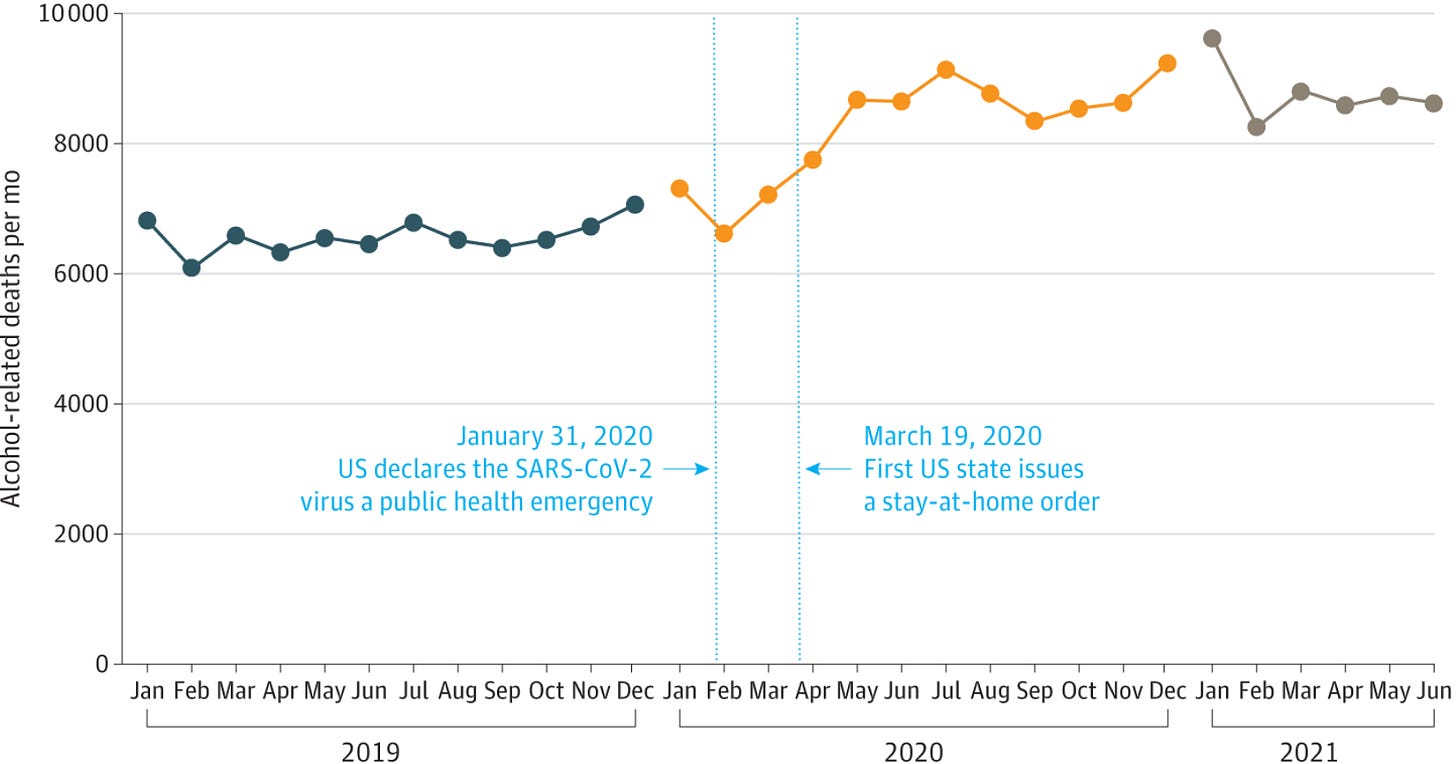

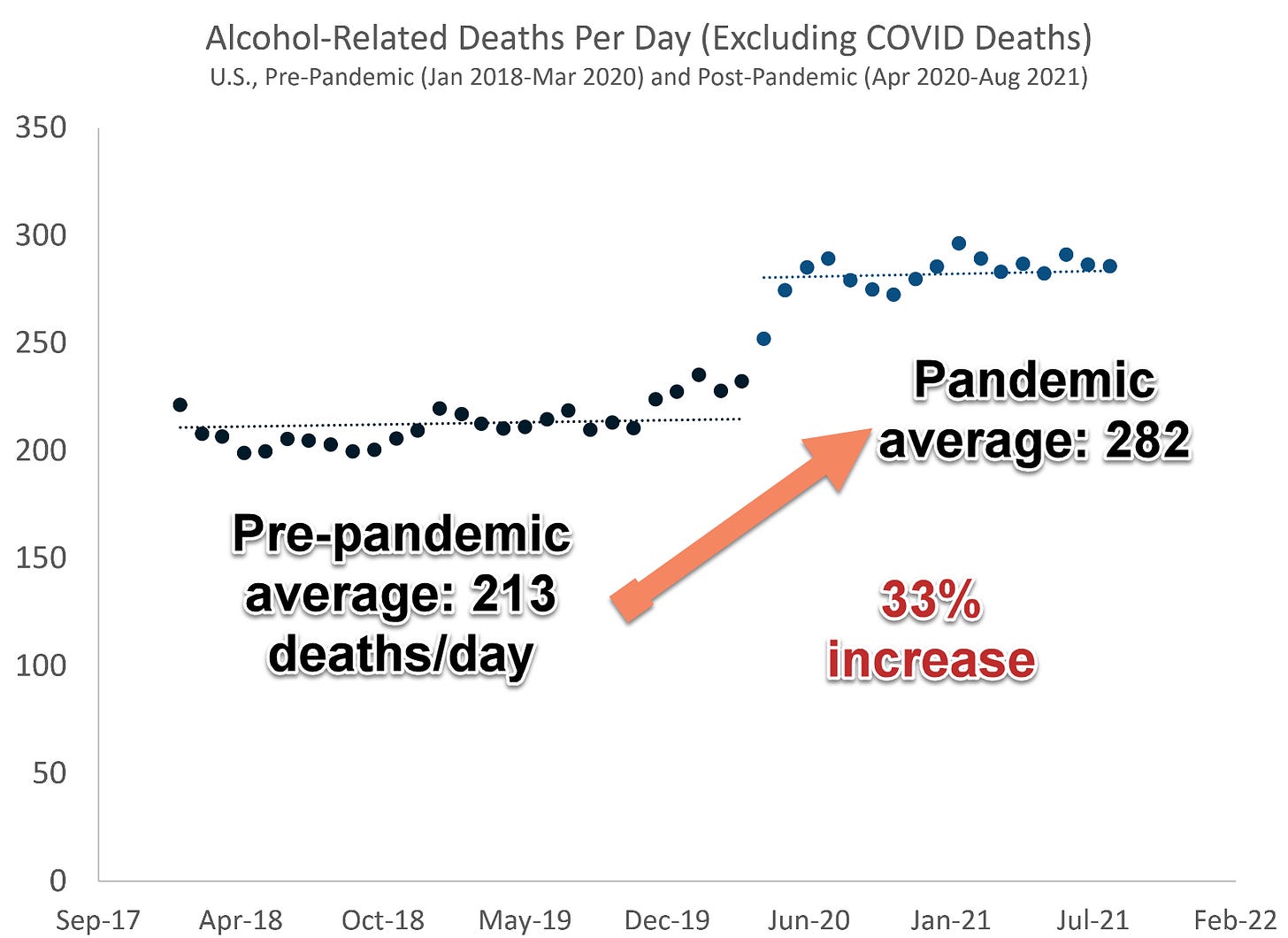
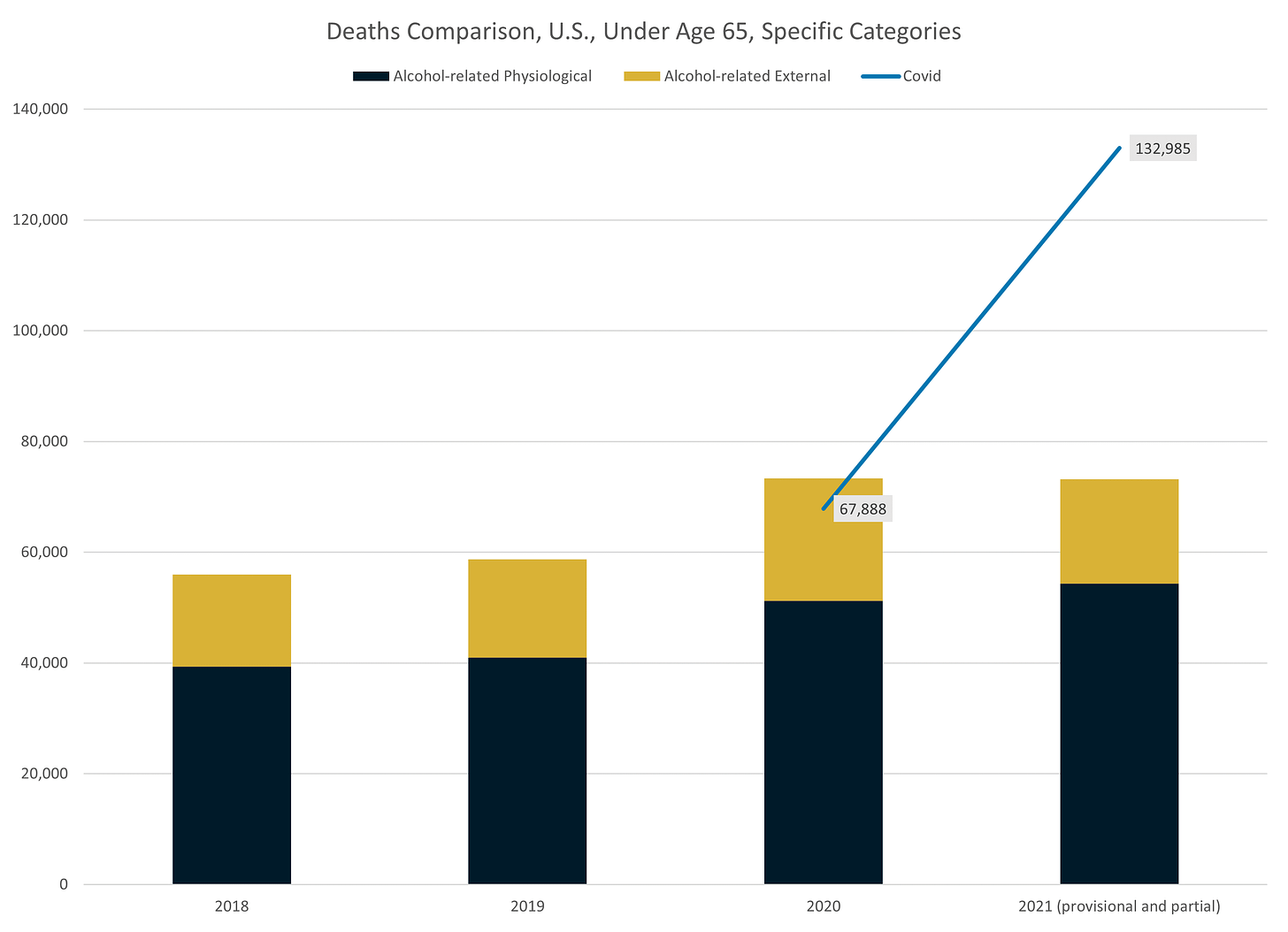
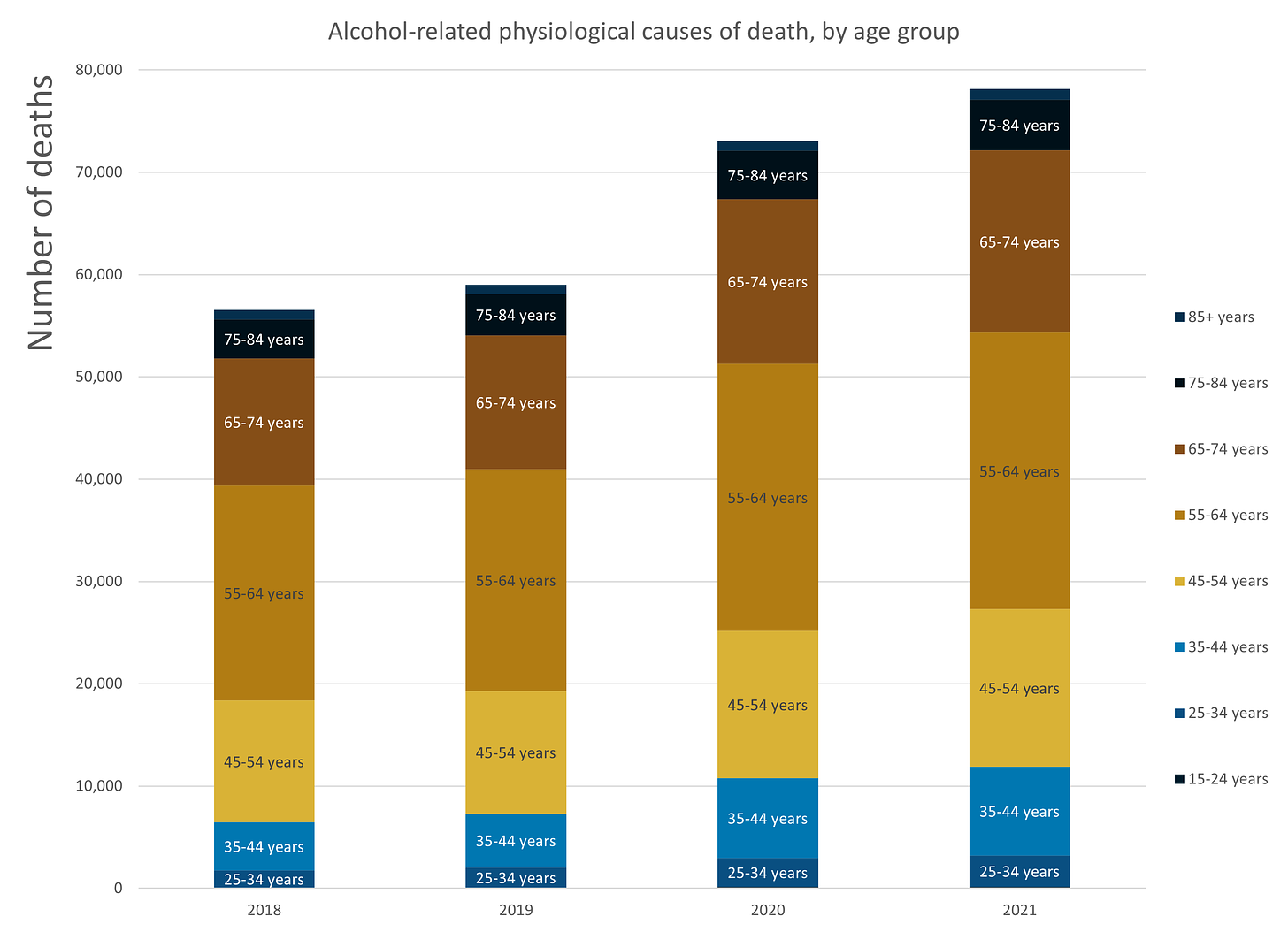
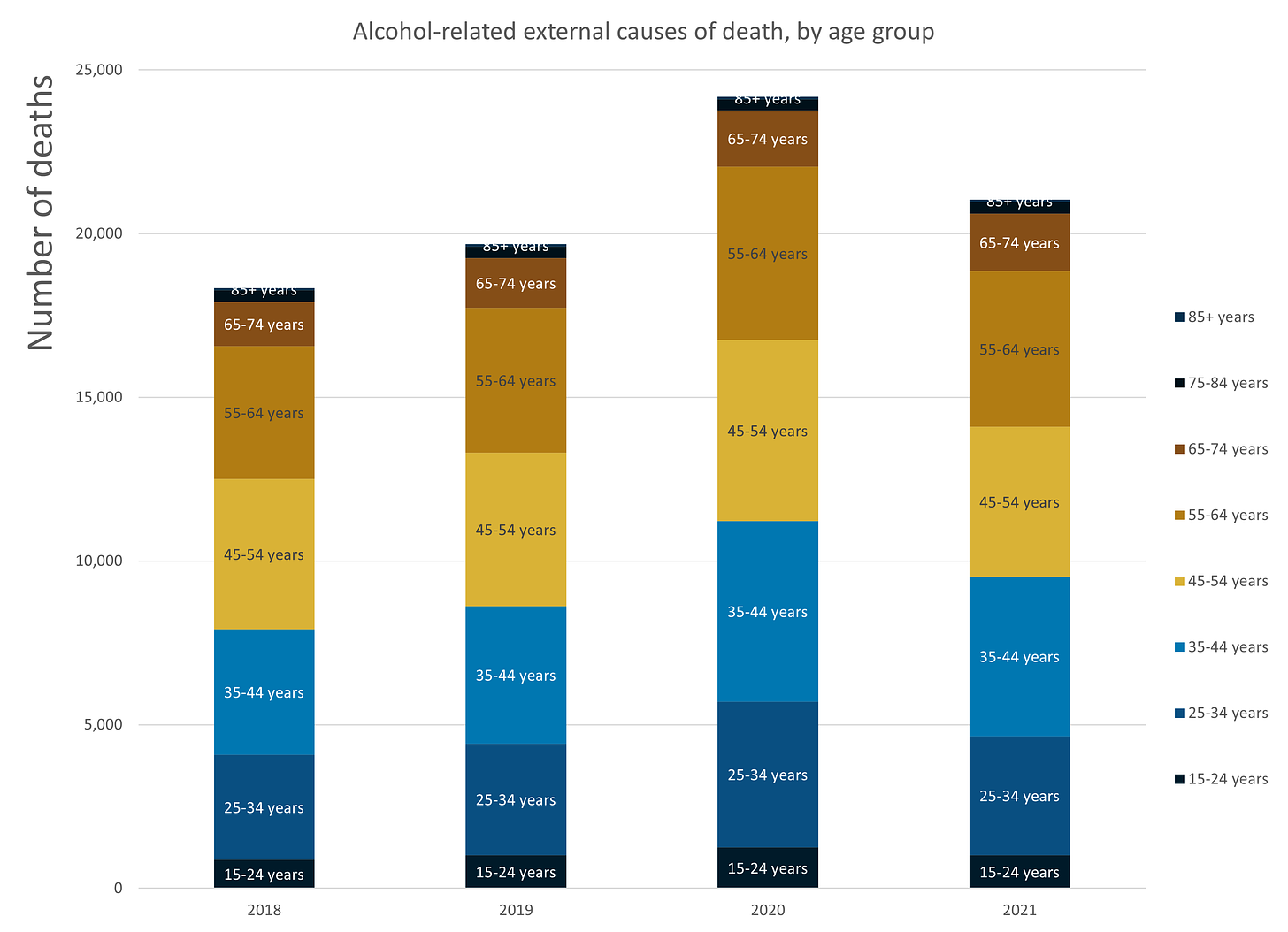




I know that around me, drinking lost its stigma after Easter and we didn't reopen. I was so terrified of what lockdowns were doing to human rights I certainly gave myself permission to drink more than I had before. Then we moved to Florida, I got a new job and things are much better. But I was in a dark place and it wasn't because I was afraid of covid or sick. It was mental and alcohol was a (terrible) coping mechanism.